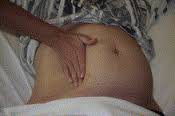Our excellent Critical Care Medicine Mini-Fellowship met last week for our monthly meeting where we actually had an inter-departmental and inter-disciplinary presence to discuss cardiac arrest in the pregnant patient.
We reviewed three articles which I have summarized for you below:
1. Management of Cardiac Arrest in Pregnancy: A Systematic Review
Turns out there aren’t so many randomized control trials on this topic. Reviewed were case series about peri-mortem C sections – turns out they are only done in the recommended initial 5 minutes of arrest <20% of the time. Amazingly, numerous case reports show women had immediate hemodynamic improvement after the procedure. One review reported 12/22! They found higher rates of baby and maternal recovery when the procedure was done within 5 minutes.
Secondly, there is no difference in impedence in the pregnant patient, and the recommendation is to shock at the same Joules as a nonpregnant patient.
Thirdly, they reviewed an interesting complication in pregnant arrest. We all know that the uterus can put pressure on the IVC, decreasing venous return to the heart. So how do you do compressions on a pregnant patient? Too tilted and they slide off, not tilted enough and you worry about IVC compression. And the strength of compressions decreases with the patient tilted! One possible solution is manual displacement of the uterus.
2. Management of Cardiac Arrest in Pregnancy
Random Fun
The discussion eventually evolved into discussing APRV, a very hip new method of ventilation. Curious? Check it out here and here
By Dr. Andrew Grock
Special thanks to Dr. Ashika Jain as usual for cooking, hosting, and teaching
andygrock
- Resident Editor In Chief of blog.clinicalmonster.com.
- Co-Founder and Co-Director of the ALiEM AIR Executive Board - Check it out here: http://www.aliem.com/aliem-approved-instructional-resources-air-series/
- Resident at Kings County Hospital
Latest posts by andygrock (see all)
- A Tox Mystery…. - May 26, 2015
- Of Course, US Only for Kidney Stones… - May 18, 2015
- Case of the Month 11: Answer - May 12, 2015
- Too Classic a Question to Be Bored Review - May 5, 2015
- Case of the Month 11: Presentation - May 1, 2015
